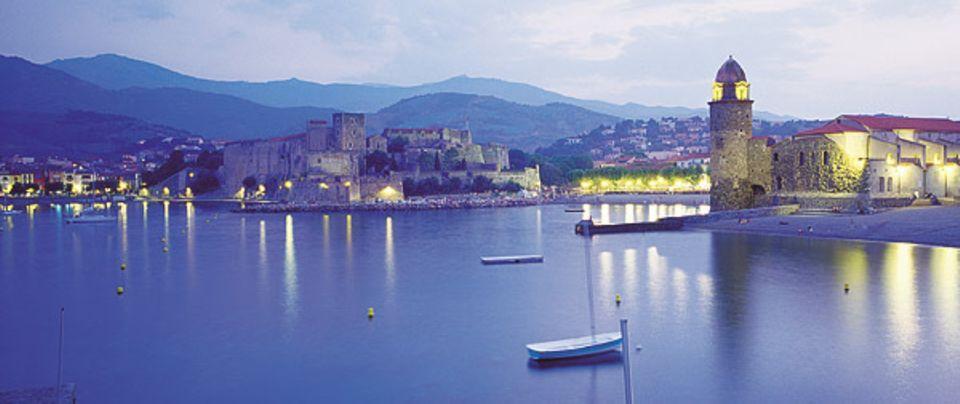Rusty red rocks, lush vineyards, the brilliant blue of the Côte Vermeille - in Collioure Henri Matisse found inspiration for his colourful works. Situated at the foothills of the Pyrenees, the harbour town also attracts visitors with its famous wine.
In the summer of 1905, Henri Matisse stepped off a train in Collioure and took lodgings in a doss house near the station. In the hot weeks following his arrival, the painter radically changed his style. The "View of Collioure" shows the parish church of Notre-Dame des Anges set on the canvas with brute verve. In the "Faubourg de Collioure", the colours of the boats clash. For conservative viewers, almost all of them, these works were a scandal. Critics gave Matisse and his fellow artists such as André Derain, who had also travelled to Collioure with his easel, the derogatory name "Fauves" - savages.
Castle and church dominate the panorama: Notre-Dame des Anges and Château Royal
© Peter Rigaud/Focus Agency
Collioure has hardly changed
On the shore, the "Chemin du Fauvisme" proves that the little harbour town still looks the same as it did 100 years ago when the art rebels arrived. Twenty reproductions of Matisse and Derain paintings line the old town and the beaches, and the motifs have hardly changed: the "Château Royal" and the salmon-red roofs, the shore path in the splashing spray and the strollers escaping to dry land.
The Castle of God
At the end of the Plage Boramar, Notre-Dame des Anges stands with its tower in the water, as if the little castle of God is about to cast off. A ring of small bathing bays nestles around the old town quarter of Le Mouré, with the Pyrenees towering in the hinterland. The whole is an explosion of colours: red, orange, green, violet, yellow. Above it, the sky, very blue: the cradle of Fauvism".
Banyul growing area
From the Route des Crêtes, vineyards stretch from an altitude of almost 600 metres to the village sign. In Collioure, the naturally sweet Banyuls has been pressed for centuries. The wines with the black cherry aroma are the trademark of the Côte Vermeille - but people are reaching for the bottles less and less. Bertrand Follet, who guides us through the vineyard for the "Maison de la Vigne et du Vin", gives the reasons: "People prefer to drink champagne with an aperitif rather than a vin doux naturel."
In addition, Banyuls suffers from the strict regulations for drivers: "It has 15 percent alcohol. And anyway, the trend is towards dry wines." The half-dozen winegrowers in the village have learned from this. They are visibly producing strong, heat-influenced red wines from the AOC Collioure and are receiving a lot of praise for this at trade fairs and in wine magazines.
The vineyards above Collioure
© Peter Rigaud/Focus Agency
The winegrowers work without machines
A breakneck path leads through the steep slopes below the Ermitage Notre-Dame de la Consolation. Slate walls hold the terraces on the slope. "A Babylonian vineyard," Bertrand jokes, alluding to the hanging gardens of Semiramis. In 1991, the small winegrower co-founded the "House of Vineyard and Wine". One year later, the "Route des Vins" was launched. The backbreaking work in the vines has not changed. Because of the slope, no machines can be used. The crate filled with grapes, which is carried down on the back during the harvest, weighs about 50 kilos.
One last panoramic view ...
We let our eyes wander over the abstract pattern of terraces into the depths. At the very bottom of the bay, framed by the green of the vines and the blue of the water, Collioure glows. Red. Yellow. Violet. As Matisse saw it.

